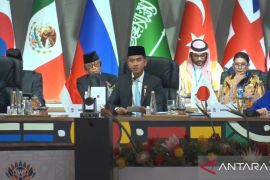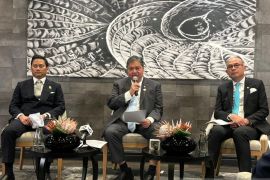Tasrif met with Managing Director for Operations Axel van Trotsenburg and Vice President for East Asia and the Pacific Manuela Ferro.
"The Indonesian government has committed to achieving a 23-percent share of new and renewable energy in its energy mix by 2025. By the end of 2021, the energy mix of new and renewable energy had reached around 11.7 percent," Tasrif noted in a statement in Jakarta, Wednesday.
In the roadmap, additional power generation after 2030 will only be from new and renewable energy power plants. Starting from 2035, power will be generated mainly by variable renewable energy sources, such as solar power followed by wind power and ocean power in the subsequent year.
Hydrogen will also be used gradually starting in 2031 and massively in 2051. Moreover, nuclear power will be included in the generation system starting in 2049.
In an effort to achieve the target of new and renewable energy to reach 23 percent of the total energy mix by 2023, the Ministry of Energy and Mineral Resources has passed regulations related to rooftop solar power plants. The government targets an additional 3.6 gigawatts of rooftop solar panels to be installed by 2025.
The minister noted that Indonesia receives maximum solar radiation, as it is a tropical country, thereby making it suitable for installing rooftop solar power plants. Moreover, Indonesia has the potential for producing wind energy, hydropower, and ocean power.
Related news: Indonesia invites G20 forum to accelerate energy transition
In his presentation, Tasrif also highlighted other efforts to achieve this energy mix, specifically through the construction of 10.6-gigawatt new and renewable energy power plants, including replacing diesel power plants with clean power plants and using biofuels of up to 11.6 million kiloliters.
"In the electricity supply plan, we have ocean currents, solar, water, geothermal, and so on. However, currently, the biggest energy source is solar energy. In addition, we have not taken into account the use of nuclear power (in the near future) but started in 2049," Tasrif stated.
Indonesia will also build a super grid to boost electricity connectivity. New transmissions between systems and islands are deemed necessary to share renewable energy sources owned by a region.
Tasrif further affirmed that the Indonesian government should build infrastructure to connect the main islands with transmission from new renewable energy power plants.
"For instance, North Kalimantan will be connected to Sumatra and Sulawesi. In addition, electricity supply from Nusa Tenggara, where there are many sources of solar energy, can be connected to Sulawesi and Kalimantan," he added.
At the conclusion of the meeting, Arifin vouched to maintain sound relations with the World Bank to achieve the planned energy transition targets.
"We will continue to work closely with the World Bank and hope we can arrange for other programs to be executed," he remarked.
Related news: How Indonesia can accelerate the sustainable energy transition at G20
Related news: Regional governments play key role in accelerating energy transition
Translator: Sugiharto P, Azis Kurmala
Editor: Suharto
Copyright © ANTARA 2022










